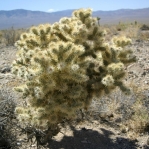Engelmann & J. M. Bigelow. 1856. Proceedings of the American Academy of Arts and Sciences 3: 305
Herbarium specimen; Herbarium specimen; Herbarium specimen; Herbarium specimen; Drawing (Britton and Rose, v 1, 1919)
Original description
Flora of North America treatment
What is Cylindropuntia echinocarpa?
Cylindropuntia echinocarpa is a common cholla in much of the Mojave and Sonoran deserts. It ranges from 50 to 1700+ m in elevation in a wide variety of habitats.
Details
G. echinocarpa is morphologically variable, ranging from low, densely branched shrubs to tree-like shrubs to 2 m tall. Stems are 3 to 12 cm long by 1 to 2.5 cm wide with 6 to 22 white, yellow, tan, or occasionally red-brown spines which obscure the stems. Sheaths range from white to yellow and are baggy. The flowers are yellow-green and sometimes tinged orange. Filaments are greenish-white to yellow. The styles and stigmas are white to light green. Fruits are tan, dry, and densely spiny. G. echinocarpa is diploid (2n = 22)
G. echinocarpa is known to hybridise with G. acanthocarpa (G. ×deserta), G. whipplei, and G. munzii. A single hybrid individual between G. echinocarpa and G. ramosissima has also been found. In his 1969 book The Cacti of Arizona, Benson designated a new taxon Opuntia wigginsii. However, it is obvious, even from the type specimen of “O. wigginsii,” that it is merely a juvenile form of G. echinocarpa. G. echinocarpa has been reported as a species parent (i.e., ancestral to) of G. fosbergii, but there is no morphological or genetic evidence to support this claim.









What is the function of the spine sheeth that easily slides off?